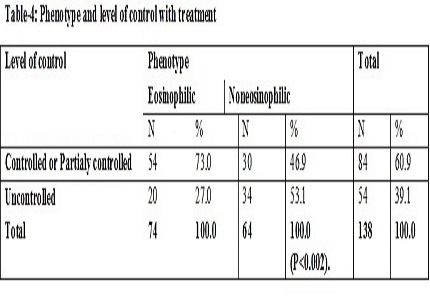Pattern of inflammatory phenotypes using sputum cytology among patients with asthma in a tertiary care centre, Kerala –A prospective cohort study
Abstract
Background: Asthma is a chronic inflammatory airway disease in which various inflammatory cells play a pivotal role in pathogenesis. Based on the inflammatory cells count in the sputum, various inflammatory phenotypes are identified. The identification of asthma phenotypes has potential clinical significance, as natural history and treatment response differ according to phenotype.
Objectives: To find out pattern of inflammatory phenotypes of asthma patients and to compare the level of asthma control after 3 months of optimized treatment in different phenotypes.
Methods: We did a hospital based prospective cohort study in the Department of Pulmonary Medicine, Medical College, Thiruvananthapuram, Kerala, over a period of one year. 138 consecutive non-smoker, asthma patients were included. Sputum was examined for differential count .The phenotype was considered eosinophilic if eosinophil count was ≥3% and noneosinophilic if eosinophil count < 3%. Each patient was reassessed after 3 months of optimized treatment and level of asthma control was assessed according to GINA guidelines.
Results: 53.6 % of study population were in the eosinophilic and 46.4 % were in the noneosinophilic phenotype. Mean age of eosinophilic phenotype was 38.4 ± 11.7 years and that of noneosinophilic was 48.8 ± 10.6 years (p<0.001). Mean BMI of eosinophilic asthma patient was 23.3 ± 2.4 and that of noneosinophilic was 24.9 ± 2.3 (p <0.001). Atopic symptoms were present in 73% of the eosinophilic phenotype and 25% of the noneosinophilic phenotype (p<0.001). There was no statistically significant difference between the two phenotypes with regard to the gender, duration of illness, family history of asthma, or initial severity of the disease. After 3 months of optimized treatment, in eosinophilic phenotype 73 % of patients became controlled or partially controlled. In noneosinophilic group only 46.9 % became controlled or partially controlled (p= 0.002).
Conclusion: Noneosinophilic asthma occured in older, obese patients, were usually non atopic and had poor asthma control after three months optimized treatment, compared to eosinophilic phenotype. Thus phenotypic classification could help to guide clinical decisions in personalized medicine approach.
Downloads
References
Global Initiative for Asthma (GINA), “Global Strategy for Asthma Management and Prevention Report,” updated 2015, http://www.ginasthma.org
Murdoch JR, Lloyd CM. Chronic inflammation and asthma. Mutat Res. 2010 Aug 7;690(1-2):24-39. doi: https://doi.org/10.1016/j.mrfmmm.2009.09.005. Epub 2009 Sep 19.
Gibson PG. Inflammatory phenotypes in adult asthma: clinical applications. Clin Respir J. 2009 Oct;3(4):198-206. doi: https://doi.org/10.1111/j.1752-699X.2009.00162.x.
Nezar R. Mohamed ,Elham A. Abdel GhanyKhalid M. Othman Analysis of induced sputum in patients with bronchial asthma: Egyptian Journal of Chest Diseases and TuberculosisVolume 63, Issue 1, January 2014, Pages 21–27.
Ankan Bandyopadhyay, Partha P. Roy, Kaushik Saha Semanti Chakraborty,Debraj Jash,and Debabrata Saha3. Usefulness of induced sputum eosinophil count to assess severity and treatment outcome in asthma patients: Lung India. 2013 Apr-Jun; 30(2): 117–123. doi: https://dx.doi.org/10.4103%2F0970-2113.110419.
Djukanović R, Sterk PJ, Fahy JV, Hargreave FE. Standardised methodology of sputum induction and processing. Eur Respir J Suppl. 2002 Sep;37:1s-2s.
Russell S. Traister, Sally E. Wenzel .Inflammatory phenotypes in asthma pathogenesis: Drug Discovery Today: Disease MechanismsVolume 9, Issues 3–4, December 2012, Pages e75–e81.
F. Wang, X.Y. He, K.J. Baines, L.P. Gunawardhana, J.L. Simpson, F. Li, P.G. Different inflammatory phenotypes in adults and children with acute asthma:European Respiratory Journal 2011 38: 567-574; DOI: https://doi.org/10.1183/09031936.00170110.
C. Raveendranphenotypes in asthma - The Association of Physicians of Indi Medicine Update 2012. Vol. 22 http://www.apiindia.org/pdf/medicine_update_2012/pulmonology_01.pdf
Sebastian Majewski,1 Maciej Ciebiada,2 Mateusz Domagala,1 Zofia Kurmanowska,1 and Pawel Gorski1 Short-Term Reproducibility of the Inflammatory Phenotype in Different Subgroups of Adult Asthma Co Mediators of Inflammation. Volume 2015 (2015), doi: http://dx.doi.org/10.1155/2015/419039.
Green RH, Brightling CE, Woltmann G, Parker D, Wardlaw AJ, Pavord ID. Analysis of induced sputum in adults with asthma: identification of subgroup with isolated sputum neutrophilia and poor response to inhaled corticosteroids. Thorax. 2002 Oct;57(10):875-9.
Berry M, Morgan A, Shaw DE, Parker D, Green R, Brightling C, Bradding P, Wardlaw AJ, Pavord ID. Pathological features and inhaled corticosteroid response of eosinophilic and non-eosinophilic asthma. Thorax. 2007 Dec;62(12):1043-9. Epub 2007 Mar 13.
Amelink M, de Nijs SB, de Groot JC, van Tilburg PM, van Spiegel PI, Krouwels FH, Lutter R, Zwinderman AH, Weersink EJ, ten Brinke A, Sterk PJ, Bel EH. Three phenotypes of adult-onset asthma. Allergy. 2013;68(5):674-80. doi: https://doi.org/10.1111/all.12136.
van Veen IH, Ten Brinke A, Sterk PJ, Rabe KF, Bel EH. Airway inflammation in obese and nonobese patients with difficult-to-treat asthma. Allergy. 2008 May;63(5):570-4. doi: https://doi.org/10.1111/j.1398-9995.2007.01597.x.
John V. Fahy. Eosinophilic and Neutrophilic Inflammation in Asthma Insights from Clinical StudiesProceedings of the American Thoracic Society: Vol. 6, No. 3|2009.
Pranab Haldar, Ian D. Pavord, Dominic E. Shaw, Michael A. Berry, Michael Thomas, Christopher E. Brightling, Andrew J. Wardlaw,1and Ruth H. Green. Cluster Analysis and Clinical Asthma Phototypes: Am J Respir Crit Care Med. 2008 Aug 1; 178(3): 218–224.



 OAI - Open Archives Initiative
OAI - Open Archives Initiative


